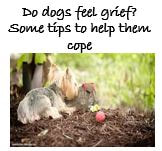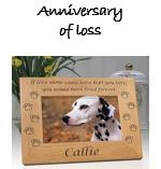What to Expect When Your Dog is Put to Sleep - Euthanasia
Euthanasia - Origin: early 17th century (in the sense 'easy death'): from Greek, from eu 'well' + thanatos 'death'
Euthanasia is the act of producing a humane death in an animal.
Scotty Valadao - Canine Behaviour Consultant : TTouch Practitioner
Having to make the decision of euthanasia is something that every pet owner dreads, but I personally find that knowing what is going to happen, helps me to prepare both myself and my dog. This came home to me 18 months ago, when we had to make the decision to let our beloved Meggie go. I had handled these situations by myself in the past, but as Meggie was very much my hubby’s dog, he wanted to be present with her to the end and I explained the process to him, so that he would know what to expect. Since then, I have had numerous questions as to what actually happens, and although this is not a subject I enjoy writing about, I do hope it will help people to understand the actual process and what is involved. As each vet has their own methods of working, I would also suggest discussing the procedure with your vet as well.
Before the Euthanasia
After discussing if the time is right with your vet, your first step is to decide if you or any of your family members want to be present. My own vet does his utmost to deal with euthanasia at a time when there are not likely to be people in the waiting room, or you can discuss with your vet if you would like the procedure to be carried out at home, although not all vet's will do this.
Deciding if you want to be present when the procedure is done, is a very personal decision and if you feel that this route is not for you, then don't do it. It does not mean that you do not love your dog, or love it less than somebody that wants to stay with their dog, or are letting it down - there are just people that cannot cope with this and that is their decision, and they have nothing to feel guilty about.
Discuss with your vet as to whether he/she thinks it is a good idea to give the dog a relaxant before bringing it to the vet’s rooms. It may be an idea to consider taking some Rescue Remedy yourself first as well.
Arrange to make payment before the time. The last thing you want is to try and sort out the finances after the event when you are going to be emotional and possibly in front of a room full of patients and you may have to wait.
Decide exactly what you are going to do with your pets after the euthanasia. Most vets’ work with companies such as Envirocin who will collect your pet after the event and follow your instructions. If you are not sure what you want done, you can read through this article ‘What do you do when it is time to make THAT decision – Euthanasia?’ which will give you some ideas.
I have had countless friends and clients tell me that they found that doing a bit of TTouch on the dog while the vet was busying himself for the procedure, helped to calm both the owner and the dog down. If you don’t know any TTouch, simply by stroking the ears you are influencing different acupressure points. The tip of the ear can stop an animal going into shock and is very relaxing. Also stroking between the eyes, over the top of the head can bring about relaxation. I did this with Meggie and it helped me to feel that I was helping her in some way. If you do know TTouch, a Wrap being put on the dog before going to the vet, will calm it even more. Take your time to say your goodbyes.
During the Euthanasia.
Even though you have discussed euthanasia with your vet, he/she will still do a physical exam before the procedure.
Prior to putting in the intravenous drip, many vets will give the dog an injection containing a sedative to make the procedure easier. This will immediately relax the dog and make it sleepy. The vet will then insert an intravenous solution of pharmaceutical agents by way of a vein, normally on the leg, where the hair is fist cut away.
Within just a few seconds your dog will become unconscious and there is no pain involved at all apart from the initial injection, which is very mild. The drug most commonly used is pentobarbital and this depresses the Central Nervous System starting with the cerebal cortexx which is the part of the brain that determines awareness. The dog becomes unconscious which progresses to anesthesia (which is the absence of pain) and because the dose is high, the breathing will slow down and stop, which causes cardiac arrest to occur, and the dog has then passed. This is a very quick process and on average only takes about 10-30 seconds from when the intravenous solution is administered.
After the Euthanasia
After the dog has stopped breathing the vet will listen to your dogs heart to confirm death and will let you know that the dog has now gone to the Rainbow Bridge.
The eyes remain open and the vet will normally close them when the dog has passed. Some dogs will urinate and/or defecate after passing and some will emit what sounds like a final breath. These are not signs that your dog is still alive, it is only a normal mechanical response and most vets will warn you that this can occur to prepare you if it does happen.
Most vets will step out of the room to allow you a few minutes alone with your dog. The vets I work with realize that this is an incredibly emotional time and will supply you with the privacy you need. If you made your arrangements beforehand regarding payment and your dog’s after care, you can simply leave when you are ready. I always feel it is a good idea to have somebody waiting for you to drive you home, even if you wanted to be alone with your dog during the procedure, as you have just done something so very difficult and your mind will not be on driving.
Many people do not realize how much the loss of a beloved dog can affect us and if you feel the need to talk to somebody about this, please don’t hesitate. People grief in different ways, but there is usually a period of mourning involved.
We do have a Wall of Remembrance on our website, and if you would like to honour your dogs memory with a picture and a few words, please just send these to us and we will do the necessary. - [email protected].
.
|
The pain of losing a beloved pet can be even more sever than that of losing a friend - this article explains just why it can hurt so much.
|
Believe it or not, dogs can, and do feel and grief, and it can be very severe. Here are some tips to help your dog is if is battling, as well as some signs that your dog is not coping.
|
The first year of a loss, is often the most difficult, with anniversary reactions happening around any period that was significant when your dog was with you – it’s birthday, when it came to live with you, going on holiday to a place you took your with dog you, the favourite walking area etc. |





